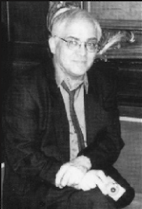By Randi Hoffman
Photojournalist and art critic Gary Azon died in his sleep of a heart attack and complications of diabetes at his home in Brooklyn on Feb. 14 at the age of 57.
Azon’s photographs of the Downtown art gallery and nightclub scene of the 1980s were published in The New York Times, New York magazine, The Village Voice, GQ, The London Times and elsewhere. He was the arts editor and columnist for Downtown magazine for 10 years beginning in the mid-’80s, and he was an organizer of art, poetry and political events.
Azon was born to a Spanish father and Dominican mother in Queens. He studied political science at Queens College. At the age of 18 he married. The marriage produced a son and lasted seven years.
For five years in the ’70s, Azon worked in The New York Times research department. And in the early ’80s, Azon was a rock music photographer for Tiger Beat, where he published photographs of Sting, Janet Jackson, Diana Ross and Cyndi Lauper.
A quiet, unassuming person, Azon was a presence in the heady, decadent ’80s art gallery scene. As art editor of Downtown magazine, he assigned articles on and covered artists such as Mark Kostabi, Ron English, Stefan Eins (at his Fashion Moda graffiti art gallery in the Bronx), Robert Petrick, Jim C., Maggie Ens, Lynn Seeney and many others.
“I was writing for the East Village Eye, and then moved on to Downtown when the Eye folded,” said Lehman Weichselbaum, one of Azon’s art reviewers and a longtime friend. “Keeping it gritty and real was always the best hallmark of East Village-Lower East Side art, and Gary had an infallible nose for putting his writers where it was grittiest and realest.”
In 1982, Azon met Dorothy Freidman August, a noted poet, teacher and literary event organizer. After a year, they moved in together and were a couple for 25 years.
“A lot of the time, we were side by side, in the same place together. When he was arts editor for Downtown, I was poetry editor for Downtown,” said Friedman August.
Friedman August said Azon obtained grants and publicized poetry series she organized for ABC No Rio, The Living Theater and Poetry on the Bay in Sag Harbor. Together they produced a performance event on Allen Ginsberg in 1992.
At the time of his death, Azon was a staff photographer for Night, a magazine covering the club and party scene. As well as being drawn to the glamorous world of socialites, Azon had a political conscience. He worked against censorship and advocated for the homeless.
“Gary was one of the eminent photographers of that era, but Gary was not an elitist,” said photographer and gallery owner Clayton Patterson. “He covered all the local shows. He gave everyone a chance. He would write up the homeless artists who ran the Chocolate Milk Gallery.”
In 1990 Azon worked with Creative Time to protest the withdrawal of National Endowment for the Arts grants from controversial artists such as Karen Finley and Holly Hughes, for their alleged use of obscene content. At a performance event called “Fighting Words,” Azon got up on stage, performed with props pulled from a Canal Jeans shopping bag, and then said, “What is obscene is attacking art and freedom of expression when in Eastern Europe the walls are coming down.”
Azon’s photojournalism included the Tompkins Square Park riots in 1988 and the aftermath of the World Trade Center attack in 2001. He gathered 41 poets to read on the steps of City Hall after the police shooting of Amadou Diallo in 1999.
Friedman August said Azon had not been in touch with his family for 35 years: “The arts people are his family,” she said.
Azon’s memorial service at the Ortiz Funeral Home on First Ave. on Feb. 27 was a fitting tribute to his creative spirit and sense of community. About 50 people crowded into the small room. Living Theater founder Judith Malina opened the proceedings and spoke eloquently of Azon’s support of his fellow artists. Performance artist and singer Phoebe Legere sang a Native American chant that was the spiritual center of the program. Michael Carter and Taylor Meade read sweet, moving poems.
“Gary lived in the interstices among us and brought us together,” said Living Theater co-director Hanon Reznikov. “He was wonderfully sensitive to the potential of art and poetry to radically affect consciousness.”


































